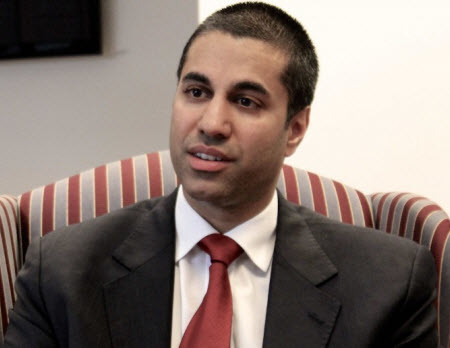Pai Circulates WiFi Remake of 5.9 GHz Spectrum
Would free up 45 MHz for WiFi, transition balance to C-V2X intelligent auto communications tech

FCC chairman Ajit Pai has circulated draft rules that would free up the majority of the 5.9 GHz band for wireless broadband while transitioning the remaining 35 MHz to the latest iteration of vehicle-to-vehicle (V2V) communications, and cellular vehicle-to-everything (C-V2X) technology.
Pai plans to vote the item at the FCC's November meeting.
The band has previously been reserved for Dedicated Short-Range Communications (DSRC) V2V communications, and the FCC had contemplated freeing up the lower 45 MHz for WiFi and leaving the upper 30 MHz for either DSRC or C-V2X. Actually, that was after it initially considered allowing V2V and unlicensed to share the same spectrum.
Auto manufacturers have argued that sharing the band with WiFi could interfere with intelligent transportation systems (ITS)/V2V safety systems, but the FCC said the new rules would improve auto safety by transitioning the upper 30 MHz from the "long-stalled" DSRC, which the FCC said "has done virtually nothing to improve automotive safety."
Others, including computer and cable companies, had argued that the FCC should free up the other 30 MHz for WiFi as well.
Related: Stakeholders Signal Support for FCC's 5.9 GHz Item
The item includes a timeline for transitioning incumbent intelligent transportation system licensees to the upper 30 MHz band, and from DSRC to C-V2X, as well as rules to allow for full-power unlicensed Wi-Fi in the lower 45 MHz band.
The smarter way to stay on top of the multichannel video marketplace. Sign up below.
This includes a proposed timeline and technical parameters for transitioning the limited number of incumbent Intelligent Transportation Systems licensees to the upper 30-MHz portion of the band (and then to C-V2X-based technology), as well as adopting technical rules to enable full-power outdoor unlicensed operations in the lower 45-MHz portion of the band.
“[The] 5.9 GHz spectrum has lain fallow for far too long," said Pai in announcing the item's circulation. "For the last two decades, the American people have waited for this prime mid-band spectrum to be put to use, and the time for waiting is over,” said Pai. “We should move on from DSRC and unlock forward-looking automotive safety technology. Under my approach, the FCC would for the first time authorize C-V2X in the 5.9 GHz band. At the same time, we would make available the spectrum needed for a 160 megahertz-wide channel for WiFi, which would enable a new level of gigabit connectivity for schools, hospitals, small businesses, and other consumers."
“At a time when American consumers are relying on WiFi more than ever before, we commend chairman Pai for taking action to enable next-generation WiFi access to the 5.9 GHz band," said Michael Powell, president of NCTA-the Internet & Television Association. "After more than 20 years of spectrum underutilization in 5.9 GHz, and a seven-year Commission proceeding, the Chairman’s compromise proposal is the right way to bring this band online, creating a new wide WiFi channel that will support more data at much faster speeds and that can be activated by early next year, while also reserving sufficient spectrum for future automotive safety innovations. We look forward to working with the chairman and his colleagues on this important item.”
“The Commission’s upcoming action to open 5.9 GHz for unlicensed use represents a critical opportunity for consumers because, with the right rules in place, we will be able to leverage the 5 GHz WiFi ecosystem already in place to deploy use of the new band very quickly,” said Craig Cowden, senior VP of wireless technology for Charter. “It couldn’t have come at a better time for our customers. Throughout the COVID-19 pandemic, WiFi has helped families stay connected and productive as they work, learn, access healthcare, and connect with friends and family from a distance, highlighting the urgent need for robust unlicensed spectrum resources to keep pace with continuously growing demand.”
Contributing editor John Eggerton has been an editor and/or writer on media regulation, legislation and policy for over four decades, including covering the FCC, FTC, Congress, the major media trade associations, and the federal courts. In addition to Multichannel News and Broadcasting + Cable, his work has appeared in Radio World, TV Technology, TV Fax, This Week in Consumer Electronics, Variety and the Encyclopedia Britannica.

